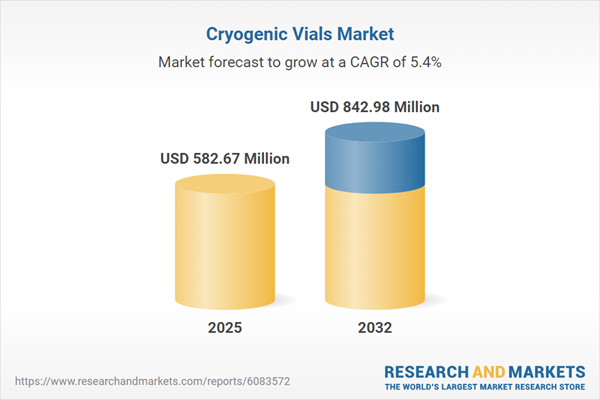Speak directly to the analyst to clarify any post sales queries you may have.
Decision-makers seeking competitive advantage in biosample management are prioritizing reliable, future-ready cryogenic vial solutions. The cryogenic vials market is adapting to shifting technology, regulatory pressures, and supply chain dynamics, positioning itself as an essential segment within life sciences and healthcare logistics.
Market Snapshot: Growth and Opportunity in the Cryogenic Vials Market
The cryogenic vials market grew from USD 552.33 million in 2024 to USD 582.67 million in 2025. It is expected to continue growing at a CAGR of 5.42%, reaching USD 842.98 million by 2032. This upward trajectory reflects strong demand from sectors focused on biosample preservation, research reproducibility, and operational scalability.
Scope & Segmentation of the Cryogenic Vials Market
This report provides granular coverage of the following market dimensions relevant for procurement and R&D leaders:
- Material: Glass (Borosilicate, Soda Lime), Plastic (Polyethylene, Polypropylene).
- Volume Capacities: 1.5ml, 2ml, 5ml, 10ml options tailored for microscale to large-scale applications.
- Sterility Levels: Non Sterile and Sterile configurations meet lab and clinical contamination control standards.
- Closure Mechanisms: Magnetic Closure, O Ring, Screw Cap, Snap Cap for enhanced containment and workflow compatibility.
- Automation Compatibility: Fully Automated, Semi Automated, and Manual platforms address throughput and handling needs.
- End User Segments: Academic & Research Institutes, Biobanks, Biotechnology Firms, Diagnostic Laboratories, Hospitals, and Pharmaceutical Companies drive adoption.
- Applications: Cryopreservation, Sample Storage, and Transport for various bioanalytical needs.
- Regional Focus: Americas (United States, Canada, Mexico, Latin America), Europe, Middle East & Africa (including major EU economies and leading Middle Eastern and African countries), Asia-Pacific (China, India, Japan, Australia, and others).
- Leading Companies: Thermo Fisher Scientific Inc., Merck KGaA, Corning Incorporated, Avantor, Greiner Bio-One, DWK Life Sciences, Eppendorf AG, Cole-Parmer, Labcon, and Simport Scientific Inc.
Key Takeaways for Senior Decision Makers
- Material advancements—such as hybrid polymers and engineered glass—are shaping product longevity and chemical integrity in the cryogenic vials market.
- Digital tracking systems and IoT-enabled monitoring are elevating inventory management and sample traceability for high-throughput operations.
- Sustainability goals are accelerating the adoption of greener manufacturing practices, including recycled inputs and energy-efficient processes.
- Quality management and regulatory compliance remain pivotal, driving demand for robust extractables/leachables testing and ISO/cGMP certification.
- Regional ecosystems display differing adoption patterns, regulatory regimes, and supply network complexities, requiring tailored market entry and expansion strategies.
Tariff Impact: Navigating U.S. Regulatory Shifts
Recent U.S. tariffs on imported raw materials and finished cryogenic vials have increased input costs and shaped sourcing decisions for manufacturers and end users. These changes are prompting a shift toward local partnerships, expanded domestic production, and just-in-case inventory models to mitigate risk and manage costs. Some organizations are investing in alternative materials and local glass technologies to enhance supply resilience, though near-term budget impacts are significant.
Methodology & Data Sources
This comprehensive analysis synthesizes primary interviews with laboratory managers, procurement officers, equipment specialists, and regulatory experts. Secondary data includes technical publications, industry filings, patent data, and company reports. Structured SWOT and PESTEL analyses and segmentation mapping supplement expert panel reviews to ensure reliable, actionable intelligence.
Why This Report Matters for Business Leaders
- Facilitates informed capital allocation, sourcing, and partnership decisions based on credible, in-depth market intelligence.
- Enables organizations to anticipate regulatory and tariff-driven risks, adapting supply chains and product portfolios accordingly.
- Supports strategic differentiation by highlighting innovation, technology, and sustainability trends shaping buyer expectations and operational priorities.
Conclusion
The cryogenic vials market continues to evolve, shaped by technology advancements, supply chain innovations, and regulatory requirements. Companies that align product development and operational models with these changing dynamics are positioned to drive sustained value and resilience in an increasingly complex global landscape.
Table of Contents
3. Executive Summary
4. Market Overview
7. Cumulative Impact of Artificial Intelligence 2025
Companies Mentioned
The companies profiled in this Cryogenic Vials market report include:- Thermo Fisher Scientific Inc.
- Merck KGaA
- Corning Incorporated
- Avantor, Inc.
- Greiner Bio-One International GmbH
- DWK Life Sciences GmbH
- Eppendorf AG
- Cole-Parmer Instrument Company, LLC
- Labcon, Inc.
- Simport Scientific Inc.
Table Information
| Report Attribute | Details |
|---|---|
| No. of Pages | 189 |
| Published | October 2025 |
| Forecast Period | 2025 - 2032 |
| Estimated Market Value ( USD | $ 582.67 Million |
| Forecasted Market Value ( USD | $ 842.98 Million |
| Compound Annual Growth Rate | 5.4% |
| Regions Covered | Global |
| No. of Companies Mentioned | 11 |









